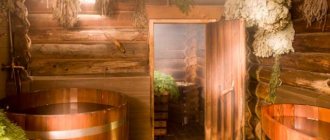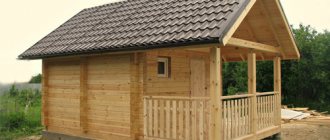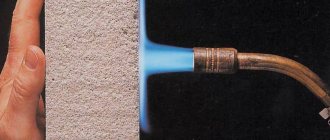Lining differs from ordinary edged boards in the presence of longitudinal grooves. They provide a tight connection between the elements. The surface after finishing is smooth, without gaps and neat in appearance.
This is why lining a bathhouse with clapboard is becoming so popular. Wood material allows you to create a microclimate favorable for relaxation in the room. The installation process is simple and easy to learn on your own.
Users often search for:
- Bath shelves
- DIY bath floor
What type of wood to choose for finishing a bath
Regular and eurolining are available for sale. The first one has a rough surface, the second one is completely smooth.
Finishers recommend using eurolining for bath lining, since the raw material has holes for ventilation, which prevents condensation from accumulating inside the material. It is made from premium quality wood and lasts many times longer.
Among the advantages of using eurolining in a bathhouse:
- Large and convenient dimensions of the groove and ridge (length can reach 8 mm).
- The presence of compensation slots ensures good ventilation of the planks and prevents the formation of cracks on the surface.
- The raw materials are already covered with a protective layer of antiseptics, which are used in rooms with high humidity and do not contain toxic substances.
The correct type of wood is also important. The list of recommended species is different for interior and exterior decoration.
Inside (dressing room, steam room)
For a steam room, it is permissible to use only hardwood with increased resistance to moisture. There should be no knots or other defects on the surface. Grade - first or highest.
You can line the steam room with clapboard from:
- aspen;
- linden;
- alders;
- oak;
- Abasha.
Coniferous species in the steam room can be used cedar, larch, hemlock. When heated, they do not release resin.
It is better to use inexpensive pine for lining the dressing room. It is not used in a steam room due to the release of resin, which sticks to clothes, and when heated, it can cause a burn.
Let's look at the properties of wood species that are suitable for finishing baths.
Alder
Hygroscopic. It has low thermal conductivity. Has a pleasant aroma. Has a beneficial effect on health.
Often used to decorate the interiors of country houses and closed gazebos. The downside is the high price. Sold in pieces up to 3 meters long.
Oak
Expensive raw materials, which is why it is not so popular. Difficult to sand or trim. But rot does not form on it. Durable. Oak lining does not require additional processing before installation.
Aspen
Color – white with a silver tint. Tree rings are visible on the surface. Light in weight. Tolerates temperature changes and high humidity well. Thermal conductivity is low. The raw material is soft. Convenient to process.
Over time, aspen lining becomes even stronger.
For periodic maintenance, when the color of the surface becomes dull, it is enough to sand it.
Linden
Many dacha owners prefer to decorate their bathhouses with linden clapboards. This is due to its beneficial properties, beautiful appearance of the material and ease of processing.
Found in light colors with a brownish or reddish tint. It has a matte shine and low thermal conductivity.
When used in a steam room, it releases beneficial microparticles. At the same time, the wood is durable and does not dry out over time.
The only caveat is that contact with iron leads to its oxidation and the formation of rust.
Abashi
This is the name of African oak. Its height in the natural environment is up to 40 m, width – 3 m.
In section, the color of the array is light yellow, cream. Abash has low thermal conductivity. The raw materials are durable. The structure is dense. Does not deform under the influence of external factors. Easy to process.
It will take a lot of money to sheathe the inside of a Russian bathhouse with abash, but such a coating will last for decades without requiring additional processing or maintenance.
Lining is not available for sale in every hardware store.
The same situation applies to ash lining - it is rare and the price is high.
Disadvantages of hardwood upholstery - the color fades over time, you have to periodically coat the surface with an antiseptic.
Coniferous raw materials are rarely used in the steam room. Since most of them, when heated, release resin. But these rocks are great for finishing walls, ceilings in washrooms and dressing rooms.
Conifers are inexpensive, easy to process, and have a pleasant pine aroma.
Let's look at the properties of the most popular of them.
Cedar
It comes in a variety of colors due to its wide range of growing locations. Available in beige to coffee shades. Durable. Resistant to differences in temperature and humidity. Requires mandatory treatment with antiseptics. The price is high.
The disadvantage of cedar lining is that it can begin to release resin after several years of use, without even heating up.
Larch
Demanded coniferous species.
Many builders line the steam room with hardwood clapboard. It can be used to cover the ceiling, walls, and in the shower, locker room, and rest room.
Does not release resin. Durable. Withstands temperature changes. Doesn't rot. Not susceptible to damage by insects.
When exposed to moisture it only becomes stronger. The structure of the wood is homogeneous. The fumes from larch have antiseptic properties.
Pine
Used for finishing work in the dressing room, locker room, and rest room. The surface of the lining is smooth. It comes in beige, brown colors with a slightly reddish tint. The structure of the growth rings is clearly defined. Resin channels are noticeable. Excellent resistance to mechanical stress. Convenient to process.
Pine is not used for lining the steam room. But if the owners do not have another lining at their disposal, then before using the steam room they will have to heat it several times to remove any escaping resin.
You only need to purchase top-class lining.
Hemlock
Coniferous species from the pine family. The tree is also called Canadian hemlock. Unlike pine, it is very durable and is not afraid of high humidity or sudden temperature changes. Therefore, hemlock clapboard is used to cover the shelves, ceiling, and walls in the steam room.
Does not rot or deform. Thermal conductivity is low. When heated, it releases essential oils that are beneficial to health.
Despite the advantages of coniferous trees, most owners prefer deciduous linden or aspen. A pleasant aroma, low thermal conductivity, and ease of processing make them popular in the decoration of baths and other premises.
Outside
For cladding the outer part of the structure, moisture-resistant larch, sometimes oak, abashi, and premium pine are purchased.
The most popular type of profile is the block house, which imitates a rounded log. In this case, the tongue-and-groove connection is preserved. The front side is round, the inner side is flat or with ventilation ducts.
Among the nuances of external fasteners:
- Openings for windows and doors are decorated with a profile (beam).
- Only the highest grade lining is used, without knots or other defects.
- Two posts are fixed at each corner.
- The fastening method is through.
- The parts are mounted with the groove down to prevent precipitation from getting inside.
An alternative to wood lining is plastic. It is resistant to any weather conditions and has a wide selection of colors, including wood imitation. The downside is that the plastic is fragile, so installation is carried out carefully, otherwise the planks may crack.
Thermal insulation of the steam room
Covering a steam room in a bathhouse involves the use of thermal insulation. In this regard, the following applies:
- rolled paper;
- mineral wool;
- Styrofoam.
If you are curious about how to cover a steam room in a bathhouse at the lowest cost, it is better to consider penoizol. Just like polyurethane foam, it is affordable and does its job well.
The most common components enclose structures and perform important functions. Different types of materials can help building owners achieve the required efficiency. For example, extruded polystyrene foam insulation offers many benefits due to the way the product is manufactured.
Energy efficient, easy to install, lightweight and identifiable by its blue, pink or green color, extruded polystyrene foam cladding can allow a single product to be used to create a continuous layer of thermal and moisture protection on a building.
Extruded polystyrene foam contains solid granules of polystyrene resin. Plastic pellets are used with an extruder, they are melted and mixed with important additives to form a viscous liquid. During installation, liquid is injected to cause the plastic product to expand. Under carefully controlled conditions of heat and pressure, the plastic mixture is forced through the cells. The rigid foam can then be cut to the dimensions of the final product.
This continuous process produces a closed cell structure. It looks like a mass of homogeneous bubbles with common walls between them. As a result, a continuous smooth film is formed on top and bottom.
The closed cell extruded polystyrene foam structure provides superior durability. Products are available in a variety of compressive strengths to suit the varying needs of builders. Due to its physical properties, strength is not dependent on the use of facing materials or laminates. sometimes they can be broken during installation. However, extruded polystyrene cladding products are available to add additional strength.
Extruded polystyrene plastic also comes in a wide variety of sizes. It has a thickness of up to 102mm, allowing it to be used in many areas. Sheathing made from extruded polystyrene foam can have a positive effect on moisture resistance. With proper use of polystyrene foam, the service life of the bath increases. It is also interesting that no toxic substances are used in the production of the insulating shell from extruded polystyrene foam.
View this post on Instagram
Posted by











